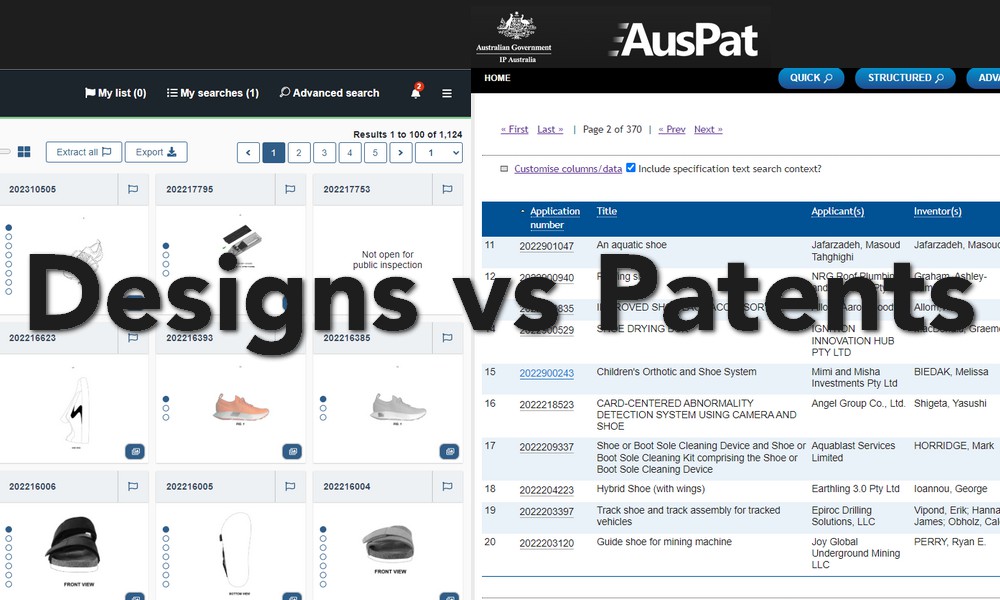04 Apr Designs vs Patents: What’s the Difference?
 Author: Ian Aldridge, Progressive Legal
Author: Ian Aldridge, Progressive Legal

If you’re a business owner in Australia, it’s important to understand the differences between designs vs patents.
Both designs and patents are intellectual property rights, providing a legal shield against other traders trying to profit from your idea and investments. Each one, however, protects a specific type of intellectual property so it’s important to know the differences.
In this article, we’ll break it down for you and help you decide which is best for your business. Keep in mind that each situation is unique, so be sure to speak with a lawyer to get specific advice tailored to your needs.
Designs vs Patents – what are they?
There is a big difference in what design rights will protect and what a patent will protect.
Design rights protect the unique look of a manufactured item, meaning an actual and tangible item, not an idea or concept, that is produced on a commercial scale. As design rights only protect the visual appearance of a product or item, they do not protect how the item works. In short, a design protects your item’s aesthetic appearance.
Some famous examples are: the shape of the Coca-Cola bottle in 1960, the Apple iPhones, Volkswagen Beetle, Converse Chuck Taylor All Star, Fender Stratocaster, Hermes Birkin Bag, Dyson Vacuum, Porsche 911, Phillips Curve TV, Apple iMac, Eiffel Tower, Swatch Watch, Sony Walkman, Boeing 747, Le Crueset Dutch Oven, Vespa Scooter, Tiffany Blue Box, Mini Cooper, Louis Vuitton Speedy Bag, Rolex Submariner, Polaroid Camera, Concorde Supersonic Jet, Super Mario Bros. Video Game.
Some famous Australian examples include: Akubra Hat, Hills Hoist Clothesline, Holden Commodore, Sydney Opera House, Ugg Boots, Blackmagic Pocket Cinema Camera, Speedo Swimwear, Vegemite Jar, Breville Espresso Machine, Boomerang, Wiltshire Staysharp Knife, Bundaberg Rum Bottle, R.M. Williams, Sydney Harbour Bridge, Billabong Board Shorts, Hills Swing Set, Holden Torana, Weet-Bix Box, Esky, Tim Tams, Victa Lawn Mower, Stubbies Shorts.
A patent gives you the right to prevent others from manufacturing, using, or selling your invention in Australia without your permission. Your invention must be new, useful, inventive, or innovative for your application to be successful. In short, a patent protects the new and innovative function, method, or the workings of a thing.
Some famous patents are: Penecillin, Light bulb, telephone, Velcro, airplane, electric guitar, ATM, walkie-talkie, post-it note, steam engine, x-ray machine, microwave oven, laser, ballpoint pen, artificial heart, pacemaker, MRI machine, automatic transmission, DNA sequencing, printing press, I-phone, 3D printing, internet search engine, self-driving car, GPS, folding wheelchair, digital camera, artificial sweetener, solar panel, wind turbine, chip and pin card, LED, hybrid car, virtual reality, airbag, seatbelt.
Some famous Australian patents are: Wifi, Airplane Black Box Recorder, Bionic ear, multi-focal glasses, ultrasound scanner, wine cask, space suit, banknotes, dual-flush toilet, spray-on skin, electronic pacemaker, anti-flu medication, fire retardant clothing, dual beam oscilloscope, electrostatic precipitator, shear blade, Hills Hoist, splayd utensil, inflatable escape slide, electric drill, titanium hip replacement, multi-needle syringe.
In other words, patents protect ideas and concepts, whereas registered designs protect the look of a certain product or item. Interestingly, you can register for patent and design protection for one and the same thing as they can offer protection for different features of the same product. As you can see from the above examples, there are some overlaps that incorporate both patent and design protection for the one product.
Take, for example, a new car brought to the market. The unique visual elements that are part of the car’s identity, adding to its value, can be protected with a design. This car’s new method of operation or new function, such as a new way to close any car doors from the driver’s seat for example, can be protected with a patent.
How to obtain Designs vs Patents?
Designs
The processes of registering a design and patent are different. However, they both start with an application to the Australian intellectual property office, being IP Australia.
An application for an Australian design is accompanied by one or more representations which illustrate the design to be protected. The representations are typically in the form of drawings but may also be photographs or digital images.
An application for an Australian design proceeds directly through to registration following a check for formalities compliance. Once registered, your design can form a barrier to the acceptance of other traders’ designs during their examination process.
Examination of an Australian design registration is optional. However, the design registration cannot be enforced until the design has been examined and then certified following successful examination.
You may wish to consider requesting examination of your design if you intend to sell or licence your design, or if you consider infringement is occurring. Obtaining a certificate of examination (Certification) will confirm that your design is new, distinctive and fully enforceable.
Without examination, contact can still be made with an alleged infringer of your design. However, formal legal proceedings will require a Certification.
Patents
A patent specification can be a lengthy and technical document and often requires more time and cost to prepare than preparing representations for a design application.
An application for an Australian standard patent undergoes substantive examination before being registered and granted. Examination of a patent application is mandatory, and your patent will be enforceable following successful examination and subsequent granting of the patent.
This difference in examination requirements increases the difficulty in obtaining a patent, and also results in a longer time period to achieve registration and grant of a patent (often years) as opposed to a design application (typically a matter of months).
The in-depth examination required for a patent also significantly increases the costs for a patent.
Duration of Protection – Designs vs Patents
An Australian registered design lasts for 5 years and can only be renewed once for another 5 years. A design right can therefore only be registered for a maximum of 10 years in Australia. In those 10 years, you have exclusive rights to commercially exploit your design.
Depending on the type of patent registered, the duration of protection differs. Standard patents last for a term of 20 years, while innovation patents last for eight years. In some instances, pharmaceutical patents can last up to 25 years. Patent protection cannot be extended once those respective terms expire, so a patent provides you with the exclusive right to exploit your invention for this duration only. However, renewal fees are due every year starting 4 years after the filing date, until the patent ends.
Key Takeaways
If the way your invention looks is what sets it apart from those of other traders, then a design may give you the intellectual property protection you need.
On the other hand, if the way your invention works is more important than the way it looks, then a patent application may be a more appropriate form of protection.
Important to remember is the substantial differences in costs for either a design or a patent – due to the extensive examination of patent applications and the annual renewal fees to maintain a patent, the costs for a patent are significantly higher.
Our team of lawyers, attorneys and specialists can provide you with tailored advice on the type of intellectual property protection you need and can help you get started to obtain this protection.
Request patent advice from one of our highly qualified patent attorneys via phone or the contact form on this page. We’ll make sure to get back to you within a day.
Tailor Made Legal Documents
We can provide you with tailored Legal Documents in a number of areas including: Intellectual Property Law, Commercial Law, Privacy Law, Workplace Law, Corporate Law, and Litigation / Dispute Resolution.
Click here to request a fixed-price Legal Document and have a look at the range of different documents we can help you with.
- 01 February, 2024
- 18 January, 2024

Ian Aldridge is the Founder and Principal Lawyer Director at Progressive Legal. He has over 15 years experience in advising businesses in Australia and the UK. After practising in commercial litigation for 12 years in major Australian and International Law Firms, he decided to set up a NewLaw law firm in Australia and assist growing Australian businesses. Since then, he has advised over 2,500 small businesses over the past 6 years alone in relation to Intellectual Property Law, Commercial, Dispute Resolution, Workplace and Privacy Law. He has strived to build a law firm that takes a different approach to providing legal services. A truly client-focused law firm, Ian has built Progressive Legal that strives to deliver on predictable costs, excellent communication and care for his clients. As a legal pioneer, Ian has truly changed the way legal services are being provided in Australia, by building Legal Shield™, a legal subscription to obtain tailored legal documents and advice in a front-loaded retainer package, a world-first. He has a double degree in Law (Hons) and Economics (with a marketing major). He was admitted to the Supreme Court of NSW in 2005.






